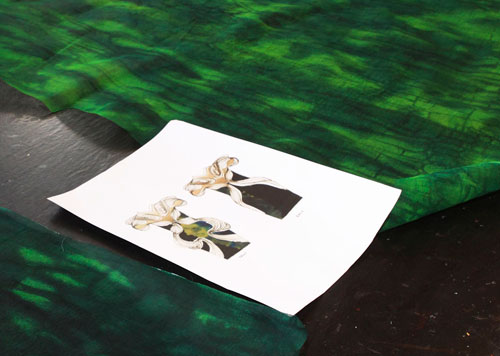Back in October, Fashion, Textile and Costume students from Edinburgh College of Art visited our entomology store at the collections centre, where they were encouraged to study, photograph and touch the insects.
Here’s a link to the original article.
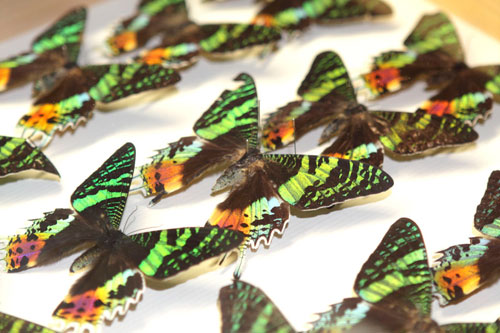
A few months on I’ve had the opportunity to see some of the finished art work and to chat about how the stunning designs developed from their initial inspiration.
The group that I visited were third year textiles students. Their project was to design a length of textile based on their observations. In addition they were to team up with the fashion students to produce fabric for a full garment. These designs had to be different, but complimentary and form a neat collection.

The lengths of textiles were exhibited at the college, as a display of stunning, shimmering, colourful fabrics which have been simply and elegantly hung and draped across mannequins.
The finished outfits from the student collaboration will be shown as part of a fashion show in May, but I was allowed a sneaky peek into the print studio to get an idea of what was being created.
Here are a few examples of the work along with some info and technical tips that the students described to me.
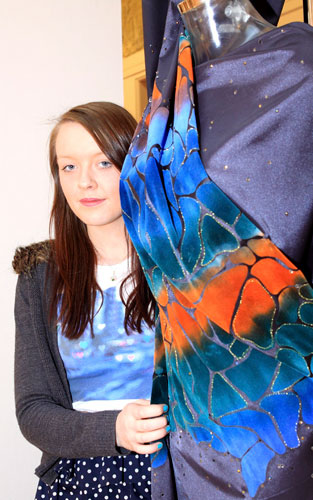
Claire’s piece was based on the vein patterns and segments of butterfly wings. She created it by painting flock sheet with coloured dyes. The flock is added to the fabric by screen printing glue onto the silk in the shape of the design. The glue is allowed to dry and then the flock is laid on top. The whole thing is pressed in a heated press, then the flock sheet is peeled away, it will only stick to the glued area creating the pattern. The use of the flock against the silk was based on the feel of the insects, as flock has a slightly rough, furry feel which is similar to some of the beetles and also represents the scaly quality of the butterfly wings.
Claire finished the piece with gold thread and hot fix crystals inspired by the jewel beetles from the collection.

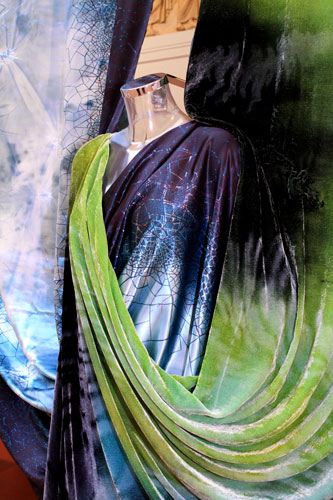
Nicola was influenced by the colours, the green, blues and blacks of the beetles. The design was created using a technique called discharging. The white length of fabric was dyed with the rich jewel colours and then a bleach-like substance is applied which partially removes the dye, allowing the subtle pattern to be created. At the bottom there is some dense beading reflecting the shapes and scaly qualities of the edges of the butterfly wings.
Liulij’s design was influenced by the transparency of butterfly wings, and their structure. Some butterflies use interference colouring, which shimmers in different shades of blue as it reflects the sky and camouflages them as they fly. This fed into the choice of colour and texture in the design. The darker parts have been printed with pigment, which gives them a heavy, more starched quality that contrasts with the lightweight silky, pale blue parts of the design.
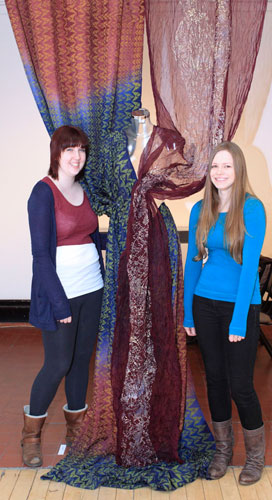
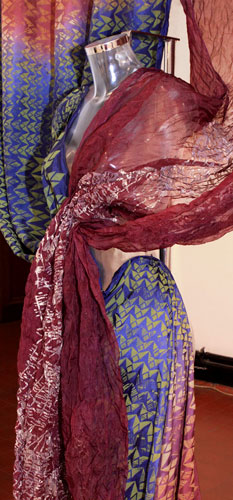
Katie was interested in the structure of butterfly wings and how they connect. Her design changes perspective to work with draping of the fabric. The material was dip-dyed and has then been printed with a technique called colour discharge. This technique works in a similar way to hair dye, as it bleaches the base colour and adds a new shade, The colour reacts differently to the different types of dye already on the fabric, creating the variety of shades.
Christina used two techniques: foil, which is similar to flocking but using a metallic foil; and Shiburi, which is a Chinese-based technique similar to tie-dying. The fabric is pleated and folded before being put in the dye, which means the material soaks up different quantities creating patterns with light and shade. Christina’s method is unusual because the foil was applied first and the Shiburi second; it was then heat set which added all the texture and crinkling, representing the translucent veined quality of insect wings.
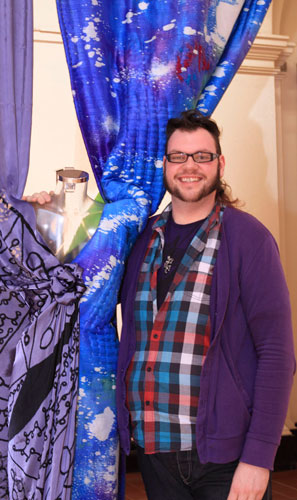
Jamie combined butterflies and space… He said that when he saw some of the specimens they reminded him of pictures of space so he’s incorporated both into his design. The colours are inspired by the jewel beetles, and he then added quilting and embroidery to provide further structure and texture. For his collaboration he’s working on a piece that uses flashes of very vibrant colour, which is similar to a butterfly using colour to warn of predators as a defence mechanism.
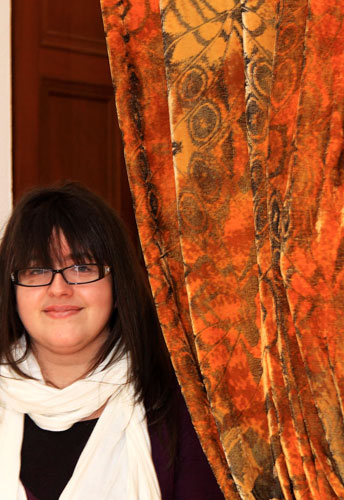
Coral created this amazing design based on tiger moths by adding pigment to velvet. Normally this would be something to be avoided at all costs as it makes the velvet clump and become rough, but it was perfect for this design as it mimicked the feel of some of the beetles in the collection.
This was an unusual project for the students as they all visited the Entomology store together as a group. They said that the explanations and anecdotes of Richard Lyszkowski (the Assistant Curator of Entomology) , were as inspiring as seeing the real specimens. I asked if their research could have been done using the internet or books, but they said it was important that they were able to see the size of the insects and to get the close up view through a microscope of the scales and to touch the specimens, as this really added an extra dimension to their work and their ideas.
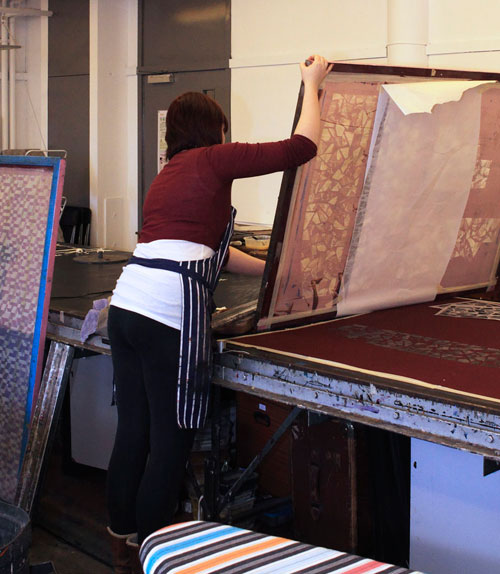
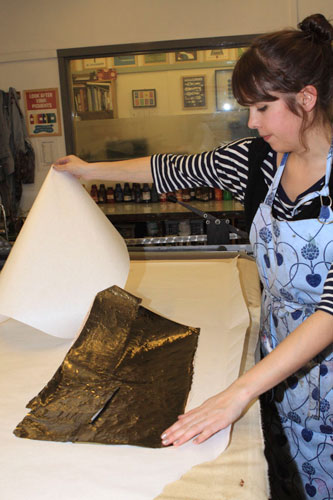
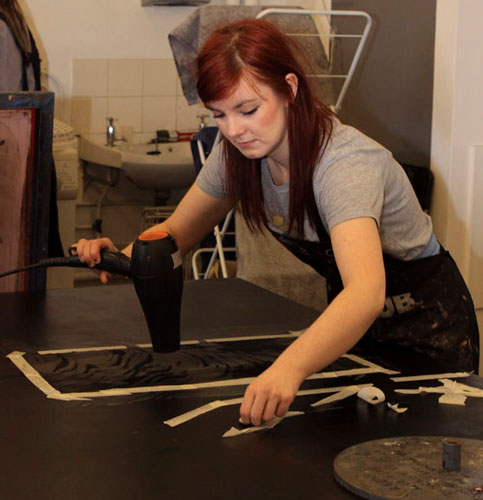
Lindy Richardson their tutor said that it’s also been different to have mixed art disciplines working together, and that the students have found it really beneficial. They’ve had to compromise and adapt or try new techniques, which has pushed them creatively. It’s also a more realistic taste of how the industry would work on projects.
I was extremely impressed by their work and really chuffed that we had been able to inspire them. I previously wondered if they could have been as inventive as nature and years of evolution, and I have to say they’re not far off!
I’m hoping to get the opportunity to attend the fashion show in May and see the final outfits, so watch this space…
